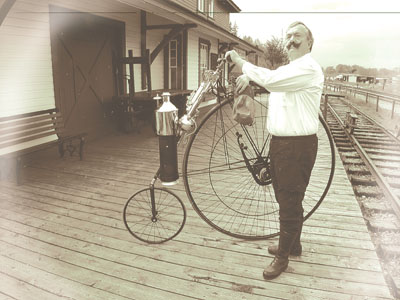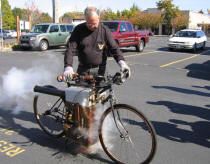|
I thought
your subscribers might like to see a couple of steam cycles
I have. The bikes are replicas of the 1884 Copeland
steamer, and the 1896 Roper. I haven't steamed the
Copeland, as its a long way to fall off, but run the Roper
regularly. I've had it up to 40mph with throttle left, but
lost nerve due to handling and minimal braking. It runs on
charcoal at 225 psi and builds steam faster that you can use
it.
Sylvester Roper had a
heart attack and fell off when riding the original, and
became the world's first motorcycle fatality.
Pete Gagan, President
Antique Motorcycle Club of America
|
||||
|
|
||||
|
Impressions from the saddle- I have yet to ride the machine, but will fill you in when I do, if I survive the experience. I’m sure “unwieldy and dangerous” will apply here as well. High-wheeled bikes are difficult enough to ride, and Stars apparently are more difficult still, without the added complication of operating a steam engine, with its water glass, steam valves, water pumps and so forth requiring constant attention. by Pete Gagan
|
||||
|
|
||||
|
A great many books on the subject of motorcycles credit Gottlieb Daimler with the invention of the motorcycle, but they are mistaken, as it all began much earlier. The Einspur was a test bed for Daimler’s internal combustion engine, but a motorcycle is described as a self propelled two wheeled cycle, or a cycle propelled by a “motor” which is device to convert heat energy into mechanical energy. Thus an external combustion steam engine is a “motor”. Steam power was highly developed during the 19th century. Steam ships crossed oceans on regular schedules, stationary steam engines drove the industrial revolution, steam locomotives pulling trains traveled across North America, and steam traction engines thrashed the grain on the prairies. Steam power was the obvious first choice for road travel as well. Road locomotives appeared in the early 19th century, but their great weight and iron wheels rendered them impractical on the dirt roads of the time. Sylvester Hayward Roper of Roxbury MA, prior to the Civil War realized the need for lighter weight on roads. He was still experimenting over forty years later. Mr. Roper was a man ahead of his time, and perhaps realized it as well, as he seems to have made no serious attempts at any patents or commercial endeavors to market any of his steam vehicles. He made his serious money as a gunsmith, invented the shotgun choke familiar to duck hunters, and did development work on Spencer firearms during the American Civil War. He also marketed a hot air stationary engine. Steam power was always a hobby with him, and in addition to his road vehicles, had two fast steam launches, named the Pickerel, and the Toothpick, and built engines for some of the fastest yachts in Boston Harbor. His first vehicle was a steam carriage that appeared on Boston streets in 1860, frightening horses and causing concern amongst the inhabitants. An ordinance was quickly passed prohibiting steam vehicles from Boston streets, but Mr. Roper was quick to point out that the same town Board had earlier appropriated $5000 to be applied to experiments “looking toward the perfecting of a self propelled steam power engine”. Bureaucracy hasn’t changed in 140 years. Shortly afterwards came America’s first motorcycle, built in 1869, just three years after the Civil War! Sylvester acquired a “boneshaker” bicycle and fitted a steam engine, boiler, firebox, water tanks etc. The boneshaker is the earliest style of bicycle, with both wheels the same size approximately, of “artillery” type- with wooden spokes, rims, and steel band tires as found on wagons and carriages of the period. Pedals are directly connected to the front wheel like a modern child’s tricycle. Sylvester fitted a twin cylinder double acting engine of his own design to the bicycle, with the connecting rods running directly to the rear axle. A sprung vertical fire tube boiler sits behind the seat, which doubles as a water tank. Presumably, feed water was hand pumped to the boiler as steam was used. Heat was provided by “Franklin” coal, that is, coal crushed to a size to fuel the then popular Franklin heaters. A flue, whose angle was adjustable, regulated the fire. This first motorcycle was used by Sylvester for 13 years, and underwent further development as he rode it. It can now be seen in the Smithsonian. Altogether, Sylvester built 10 steam vehicles between the years of 1860 to 1894, with two, three, and four wheels. His second motorcycle was a tricycle, which was lighter than the boneshaker, but still heavier than he felt ideal. He didn’t attempt to “steam up” a high-wheeled bike when they became the rage, unlike his contemporary, Lucius Copeland, who did so. Copeland was very athletic, and operating a steam engine from such a high perch would require a certain degree of co-ordination. When the “safety” bicycle with both wheels the same size, and pneumatic tires arrived on the scene, Sylvester eagerly acquired a new Columbia. The pedal cranks and bottom bracket were removed, and the bike was raised in height by extending the front forks and frame, in order to make room for a fire tube boiler below. The rectangular boiler contained 84 vertical fire tubes, made from 12gauge shotgun barrels- a legacy from a lifetime as a gunsmith. In order to get the power to the ground, Roper fitted a single cylinder double acting engine having a 1 ¾” bore x 4” stroke to the right rear frame member acting directly on the rear axle via the connecting rod. On the opposite side, a water pump having a bore of ¼” and a stroke of 1” was similarly connected to the rear wheel, and fed feed water to the boiler from a tank above, shaped and located not unlike the gas tank on a modern motorcycle. Leather “saddlebags” carried a supply of Franklin coal for the fire below. The smokestack, or flue, like that of the earlier machine, could be angled upwards when stationary, and rearwards when blasting down the road, so as to force induction. This was a true motorcycle, without pedals. Pedals were retained on some full sized motorcycles as late as 1916, not unlike the way masts were retained on steamships in earlier years- tradition lingers. Sylvester threw tradition to the wind. This last motorcycle was Roper’s masterpiece. From its birth in 1894, until 1899, he used it, and developed it continually. Contemporary reports had him traveling to the yacht club, whereupon he would remove hot coals from the firebox, which he would use to light up his steam launch. After his sea voyage, he would reverse the process, and travel home on his steam cycle. Enough water could be carried for a journey of about 20 miles at a time. Sylvester may also have been the world’s first motorcycle speed merchant. The first public showing of the steam cycle took place at the Charles River track, where he did two laps for a total of a mile in just over two minutes. No doubt excited by his success, he let pressure build up again, and took off at a speed estimated by some bystanders at close on 60 miles per hour. Suddenly, he slumped over the front end, cutting off the steam, and crashed to the ground, dead of a heart attack at aged 73. This heart attack precipitated what may have been the world’s first motorcycle fatality. Sylvester Roper was America’s first motorcyclist, and is deserving of his recent appointment to the AMHF Hall of Fame. This last Roper steam cycle is currently on display at the AMHF Motorcycle Hall of Fame Museum in Pickerington Ohio, near Columbus, and is little changed since that fatal day in 1899, missing only its boiler cladding and footrests, which were damaged in the accident. If it wasn’t for its value and age, it could run again.
|
||||
|
|
||||

